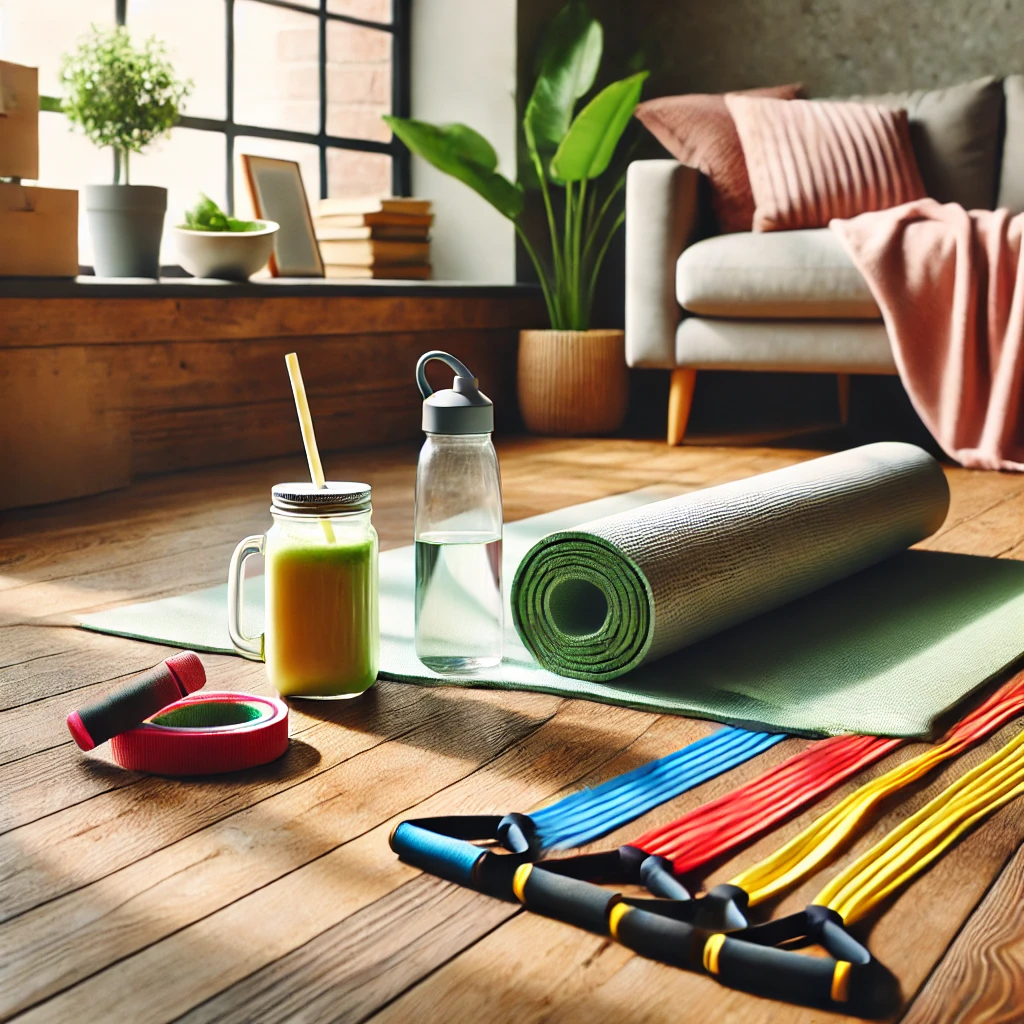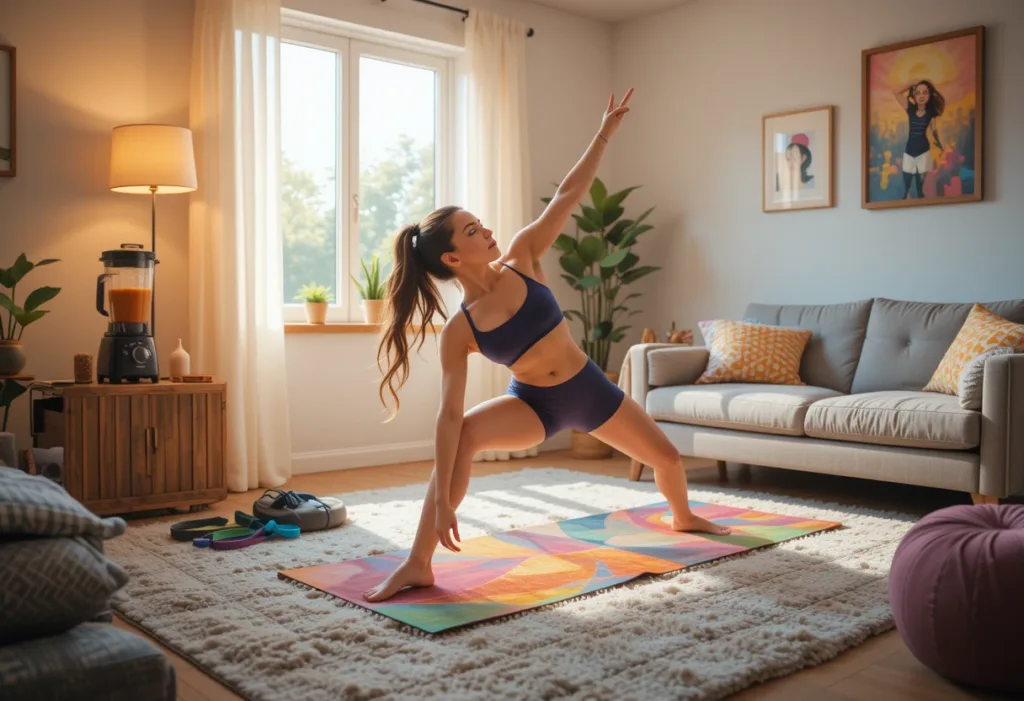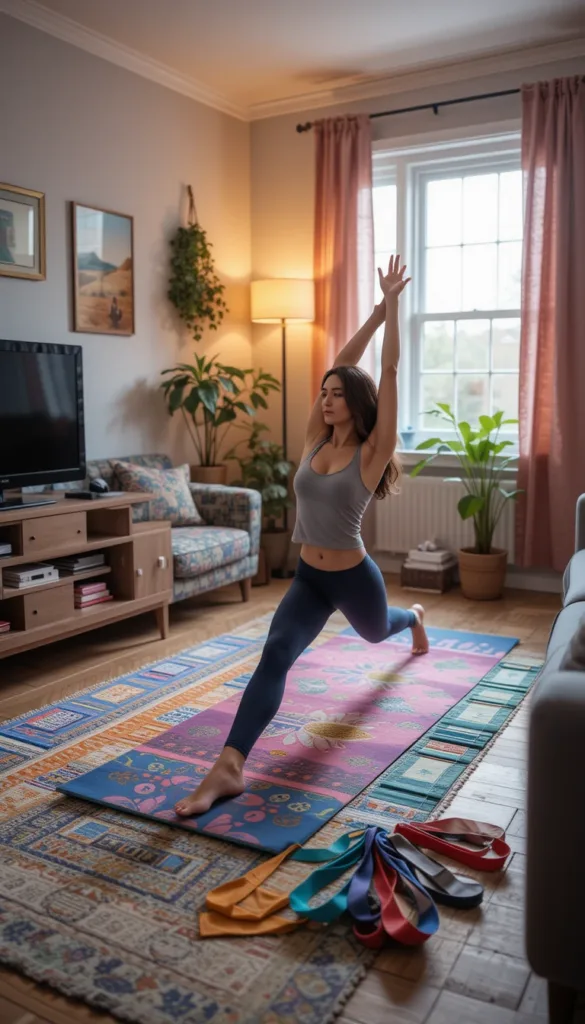
You don’t need a fancy gym to get fit—let’s explore how to create the best home workout routine on a budget!
Let’s be honest. Gym memberships can be a drag—not just on your time but your wallet, too. Between monthly fees, commuting, crowded equipment, and awkward locker rooms, the whole gym scene isn’t for everyone. But what if I told you that you can burn fat, build strength, and boost energy—all from the comfort of your home?
Here’s the deal: home workouts aren’t just a backup plan—they can be your main strategy for staying fit without the fuss. Imagine rolling out of bed, throwing on your comfiest clothes, and knocking out a full-body workout in your living room. No commute, no judgment, and no overpriced memberships.
In this guide, we’re breaking down exactly how to build the best home workout routine that saves you money, fits into your schedule, and keeps your fitness goals on track. We’ll show you affordable tools like yoga mats and resistance bands, share nutrition tips (hello, budget-friendly protein!), and give you a beginner-friendly workout plan that works. Ready to make fitness affordable, flexible, and fun? Let’s go!
Let’s face it—life gets busy. Between work, errands, family time, and that occasional Netflix binge, finding time for fitness can feel impossible. That’s why home workouts are a game-changer, especially for beginners.
Whether you’re a night owl or an early riser, squeezing in a quick sweat session is so much easier when your workout zone is just a few feet away. No driving, no parking, no dealing with gym hours—you’re in control of your schedule. Want to work out in your pajamas at 6 a.m.? Go for it. Prefer winding down with yoga at night? Totally your call.
And here’s the best part—home workouts remove the mental barrier of “getting ready” for the gym. No need to pack a bag, find matching socks, or brave cold weather. It’s just you, your space, and your goals.
The flexibility of working out at home also means you can break up your routine. Don’t have a full hour? No problem. Squeeze in a 10-minute resistance band circuit in the morning and a quick yoga flow before bed. Fitness becomes part of your lifestyle, not just another task on your to-do list.
One of the biggest myths about fitness is that you need a pile of expensive gear or a premium gym membership to see results. Not true! The reality is, with just a couple of affordable home fitness tools, you can create an entire workout system that builds strength, boosts flexibility, and burns fat—without breaking the bank.
Let’s talk essentials: a yoga mat and a set of resistance bands. That’s it. With those two tools, you’ve got everything you need for bodyweight exercises, strength training, core work, and even recovery sessions. No need for bulky weights or machines. Resistance bands give you adjustable tension to build muscle, while a good yoga mat supports your body through every movement.
Think about the savings—no monthly gym fees, no gas money, no parking stress. Plus, these tools are one-time purchases that last for years. You can literally start your entire fitness journey for under $50.
Bottom line? Affordable home fitness isn’t just possible—it’s powerful. You don’t need to spend big to feel strong, energized, and confident.
Starting a new fitness journey can be overwhelming. There’s all this jargon—HIIT, macros, split days—and it’s easy to feel lost before you even begin. That’s why home workouts are perfect for beginners: they’re scalable. You can start simple and gradually level up as your strength and stamina improve.
In the beginning, your routine might look like 10-minute bodyweight sessions using a yoga mat—think planks, stretches, and push-ups. As you gain confidence, resistance bands help you add strength work like squats, rows, and curls. You’re not locked into a fixed program. You get to grow at your pace, customizing each session based on how you feel that day.
And here’s a tip: the best part about a beginner workout plan at home is that there’s zero pressure. You’re not competing with anyone. No judgment, no mirrors, no comparison. It’s just you showing up for yourself—day by day.
You can track progress by increasing reps, switching resistance levels, or trying new moves. Before you know it, you’ll be doing routines that once felt out of reach—all from the comfort of your home.
Your yoga mat isn’t just for yoga—it’s your go-to surface for everything from stretching to strength training. The best yoga mat for beginners is versatile, comfortable, and built to keep you safe while you move. And yes, it’s affordable too.
When shopping, look for a mat that has:
A quality mat turns any space into your personal gym. Use it for crunches, planks, yoga poses, push-ups—you name it. It cushions your body, absorbs shock, and helps you focus on form without slipping.
Want a recommendation? The BalanceFrom GoYoga All-Purpose Mat is a favorite. It checks all the boxes: thick padding, excellent grip, and comes with a carrying strap. Best of all, it’s super budget-friendly.
If there’s one tool that deserves a permanent spot in your home gym setup, it’s a set of resistance bands. Lightweight, portable, and super effective, they help you train every muscle group—without lifting a single dumbbell.
The best resistance bands for home workouts are:
What’s awesome is how resistance bands grow with you. Start light, then level up as you get stronger. You can mimic gym machines (like cable rows or leg presses) with just bands. They’re ideal for strength training, toning, and rehab work—all in one neat package.
Try the Fit Simplify Resistance Loop Band Set—they’re color-coded for different strength levels, come with a training guide, and fit in your pocket.
When you start working out—especially strength training—your muscles go through tiny tears that need repairing. That’s where protein comes in. It’s your body’s recovery hero, helping to rebuild and strengthen muscle tissue, boost energy, and keep you feeling full.
Many beginners think protein is just for hardcore bodybuilders. Nope! Even if your goal is simply to tone up or feel stronger, protein is essential to your progress. Skipping it could slow down recovery and leave you sore for days.
For home workouts, especially when you’re not tracking every macro, a simple protein shake after training is a smart, stress-free way to support your body. And no—you don’t need fancy powders filled with chemicals or animal products. Plant-based options are just as effective (and often easier to digest).

Let’s bring it all together. This sample beginner workout plan is designed for your home setup, using just a yoga mat and resistance bands. It’s perfect for anyone starting their fitness journey—simple enough to follow, effective enough to build strength, cardio, and flexibility.
Routine Format:
Each session targets a different goal—strength, cardio, and recovery. You’ll build muscle, burn fat, and improve flexibility in a balanced, beginner-friendly way.
Stay tuned for Day 1, 2, and 3 plans in the next section.
B. Day 1: Full-Body Strength
Welcome to Day 1 of your best home workout routine—full-body strength training! This session is all about building muscle and improving overall body strength using resistance bands and your yoga mat.
Here’s your full routine (do 4 sets of each, resting 30–60 seconds between sets):
This combo activates major muscle groups—legs, chest, back, and arms. By doing compound moves like squats and push-ups, you’re not just building strength—you’re also boosting metabolism and burning calories.
Start light and increase band resistance as you progress. The key is good form and consistent effort, not rushing through reps. By the end of this session, you’ll feel the burn—but in a good way!
Let’s rev up your heart rate and fire up those abs! Day 2 focuses on cardio and core conditioning. These exercises improve endurance, burn fat, and tone your midsection—perfect additions to your beginner workout plan.
Do 3 rounds of the following (30 seconds per move, rest 1 minute between rounds):
These moves help you build core strength and burn calories. Plus, using the band during twists adds resistance that targets your obliques—those muscles on the side of your abs.
Remember to warm up with a light 2–3 minute stretch on your yoga mat (think cat-cow, toe touches, or arm swings). After the circuit, cool down with a few deep breaths in child’s pose or downward dog.

Your body deserves recovery time—and Day 3 is all about active rest. This yoga session promotes flexibility, reduces soreness, and helps prevent injury. Plus, it’s a peaceful way to round out your week.
Here’s your yoga flow (hold each pose for 5–10 deep breaths):
Yoga not only helps you recover—it also improves posture, breathing, and mental focus. You’re not just resting; you’re actively preparing your body for the next workout.
After your session, refuel with a smoothie using the best vegan protein powder for 2025. Quick recipe:
One of the biggest mistakes beginners make? Going too hard, too fast. Burnout happens when we expect results overnight. The key is to start small and build momentum.
Set realistic goals—like working out 2–3 times a week consistently for a month. Focus on how you feel rather than the number on the scale. Are you sleeping better? Feeling more energetic? Those wins matter!
Tracking progress also boosts motivation. Use a simple notebook or a fitness app. Note your reps, how the resistance feels, or even your mood before and after workouts.
Fitness is a journey, not a race. Progress isn’t about perfection—it’s about showing up, one session at a time.
You don’t need a full home gym, but having a dedicated corner can help you stay consistent. It’s a subtle psychological cue: when you see your mat and bands laid out, you’re more likely to get moving.
Set up a space where you feel comfortable—near a window, beside your bed, or even in the hallway. Roll out the best yoga mat for beginners, hang your resistance bands on a hook, and maybe light a candle or play a playlist to set the mood.
Your space should feel inviting, not like a chore. Treat it as your personal retreat—a place where you can reset, recharge, and build the body you want.
Nothing keeps a routine going like a good reward—and in fitness, your best reward is a delicious, protein-packed shake! After each session, blend up the best vegan protein powder for 2025 and sip it like a victory drink.
Protein helps muscles recover and keeps you feeling satisfied, which is key if you’re working toward weight goals. Plus, with plant-based options, you’re getting clean fuel without added junk.
Try different combos: almond butter, oats, berries, cocoa powder—you’ll never get bored. Enjoy your shake as a tasty ritual after each workout.
Your needs will evolve as you get stronger. That’s the beauty of a home-based, beginner workout plan—it grows with you.
Track your sessions—what exercises you did, how many reps, what resistance band level you used. Then, every 2–3 weeks, bump it up. Add more reps, try a harder band, or increase time per set.
Adjust based on how you feel. Too sore? Take an extra rest day. Not feeling challenged? Push a little harder. Fitness isn’t rigid—it’s flexible and personal.
With just your yoga mat, bands, and determination, you’ve got everything you need to progress at your own pace.
Let’s wrap it all up: you don’t need a fancy gym, a personal trainer, or a bank-breaking budget to build the best home workout routine. Everything you need to succeed—tools, exercises, and nutrition—is right at your fingertips, and it won’t cost a fortune.
With just a yoga mat, a set of resistance bands, and some smart nutrition powered by the best vegan protein powder for 2025, you can start transforming your body and health from the comfort of your living room. No stress, no pressure—just real results that build over time.
Here’s what your fitness starter pack looks like:
Start simple: follow the 3-day workout plan we laid out, create a space you love, and reward yourself with tasty post-workout shakes. As your strength and confidence grow, your routine will evolve right along with you.
Fitness doesn’t have to be complicated or costly. This is your roadmap to affordable home fitness that actually works—no gym required.
You’ve got this. So grab your mat, unroll your bands, and take that first step. Your body—and your wallet—will thank you.
Absolutely. With a consistent home routine using just a yoga mat and resistance bands, you can build strength, burn fat, and improve your health. The key is consistency, not location.
You can build an effective setup for under $50. A good yoga mat and a set of resistance bands are all you need to start. These tools are versatile and last for years.
Yes! The best vegan protein powder for 2025 offers all the essential amino acids needed for muscle repair and growth. It’s a clean, affordable option for recovery.
No worries—life happens. Just pick up where you left off. Progress isn’t about being perfect; it’s about showing up regularly and staying committed over time.
Definitely. Resistance bands provide tension that challenges your muscles like weights do. They’re especially great for beginners and can be scaled as you get stronger.
View all